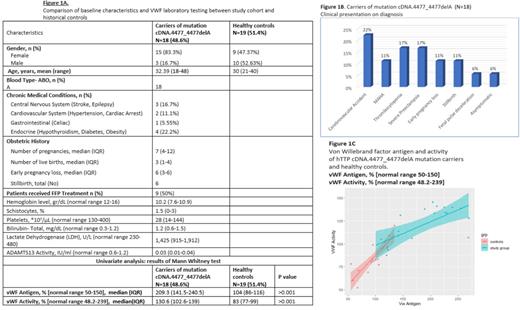Abstract
Background: Mutations in the ADAMTS-13 gene in patients with hereditary thrombotic thrombocytopenic purpura interfere with production or function of ADAMTS13 (a disintegrin and metalloproteinase with a thrombospondin type 1 motif, member 13) enzyme and increase levels of highly active large von Willebrand factor (vWF) multimers. Recent data from a cohort of hTTP patients carrying cDNA.4477_4477delA mutation in ADAMTS-13 gene suggested a discrepancy between ADAMTS13 activity and severity of clinical presentation. We proposed that the levels and activity of vWF might be elevated and associated with disease severity. In the present study we evaluated the levels and activity of vWF from homozygous cDNA.4477_4477delA mutation carriers in comparison to an historical cohort.
Methods: In this retrospective cohort study all patients were diagnosed and treated at Soroka University Medical Center, Beer Sheba, Israel. Diagnosis of hTTP was confirmed by abnormal low levels of ADAMTS13, lack of anti-ADAMTS13 antibodies and positive testing for cDNA.4477_4477delA mutation. Patients' data were collected prospectively, while pre-enrollment data were collected retrospectively from the hospital records. The tests for von Willebrand factor activity (vWF:RCof) and von Willebrand factor antigen (vWF:Ag) were performed on non-pregnant patients and before FFP transfusions were initiated.
Patients' vWF:RCof and vWF:Ag levels were compared to the values from previously published data of healthy subjects (Kilercik et al, Biological variations of ADAMTS13 and von Willebrand factor in human adults, Biochem. Medica. 24 [2014] 138-145). The data were analyzed using descriptive variables. vWF:RCof and vWF:Ag levels were compared using Mann-Whitney test.
Results: Study population included 18 adults (15 female and three male patients) from two related families, all homozygous for c.3772 delA mutation. The age at initial presentation ranged from 18 to 48 years (mean 28.7±8.8). 17 patients were identified through episodes of microangiopathic hemolytic anemia (MAHA), thrombocytopenia, vascular and pregnancy complications (see Figure 1B). One subject was detected due to family history as part of family screening. Symptomatic patients received FFP transfusions every two weeks. Pregnant patients received FFP transfusions at a dose of two units every two weeks until the week 20 and thereafter two units weekly until delivery. All patients responded well to FFP transfusions. We did not observe hTTP-related mortality among study participants. Figure 1A shows the comparison with an historic control group. The control group had similar size (19 vs. 18 subjects in the study group). The patients in our study group were slightly older and had a female predominance (83.3%), while the control group had 47% females and 53% males.
All 18 patients in our cohort had blood group A, 15 (83%) have been Rh positive. 14 patients (82%, 12 females and two male) were thrombocytopenic on initial presentation (median, 28 x103/µL, interquartile range [IQR] 14 x103/µL - 144 x103/µL). 13 patients (73%) were anemic (median hemoglobin 10.2 gr/dL, IQR 7.6 gr/dL - 10.9 gr/dL). Lactate dehydrogenase (LDH) (median, 1425 U/L, IQR 915 U/L - 1912 U/L) was elevated in 16 patients (89%) during initial presentation. Seven patients (39%) had a schistocyte count ≥1% on peripheral blood smear.
Values of vWF antigen (vWF:Ag) (median 209.3% [range 141.5-240.5%] vs. 104% [range 86-116%], p value <0.001) and vWF activity (vWF:RCof) (median 130.6% [range 102.6-139%] vs. 83% [range 77-99%], P value <0.001) were significantly higher in the study group than in healthy controls, respectively (Figure 1A, 1C).
Conclusions: Our results demonstrate that the levels of vWF antigen and activity in patients with hTTP are significantly higher than in healthy controls. These findings prompt further evaluation of vWF as a possible biomarker for the severity of hTTP.
Disclosures
No relevant conflicts of interest to declare.
Author notes
Asterisk with author names denotes non-ASH members.


